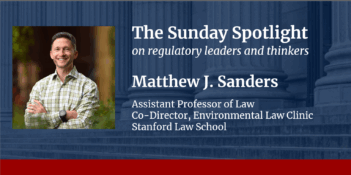
New study suggests some of the debate over environmental regulation stems from data differences.
Heralded as lifesavers by advocates and derided as job killers by critics, federal air pollution rules have for decades generated an outsized portion of litigation and political controversy. Proponents of these rules highlight health and environmental benefits, while opponents raise concerns about compliance costs and delivering reliable electricity service through the power grid. How helpful are environmental benefits, the opponents argue, if the same regulations prevent utilities from keeping the lights on?
In a recent paper, two University of Texas Law School professors, David E. Adelman and David B. Spence, attempt to change the tenor of these debates by recalculating data cited by different stakeholders so that they use the same scale. The scholars theorize that U.S. energy policy debates are so intense in part because national and regional authorities “talk past” one another rather than having meaningful discussions of the same facts and models.
Officials often present data differently depending on their area of authority. For example, the White House and the U.S. Environmental Protection Agency (EPA) frequently quantify environmental regulation benefits in terms of national averages. Electricity grid regulators, on the other hand, operate at a regional or state level and thus cite the difficulties of compliance in terms of their relevant territories.
Thinking about how to bring regulators at different levels onto the same page, Adelman and Spence examined how the federal data for three EPA air pollution rules would translate from national averages to region-specific statistics. Their analysis revealed that regions with the highest compliance costs from air pollution regulation typically also enjoyed the greatest benefits. In addition, Adelman and Spence discovered that power plant closures anticipated by the EPA rules were largely those facilities already reaching the end of their productive lives and roughly tracked the proportion of coal in the region’s energy mix.
Adelman and Spence broke down the regional costs and benefits for three major Clean Air Act rules. The rules included the Cross-State Air Pollution Rule (CSAPR), which limits emissions from power plants that create interstate fine particle or ozone pollution, and the Clean Power Plan (CPP), which regulates carbon emissions from power plants. The scholars also examined the Mercury and Air Toxins Standards, otherwise known as the MATS rule, which controls mercury and toxins emissions. Although the MATS rule returned to the headlines in 2015 when the Supreme Court found that the EPA needed to recalculate emissions limits to account for compliance costs, the rule remains in force today.
In analyzing these three rules, Adelman and Spence focused on two key points of opposition frequently raised by state and regional regulators: power grid reliability and costs of compliance. Anticipated closures of coal-fired power plants particularly concern some state and regional regulators, who think that the EPA rules will most likely lead some coal-fired power plants to shut down because the necessary pollution control equipment will render them unprofitable.
Regional opposition to the EPA rules differs in part because reliance upon coal-fired power varies dramatically across the United States. In fact, states in three Regional Transmission Organizations (RTOs), concentrated in the South and Midwest, account for two-thirds of the nation’s coal electricity generation. Unsurprisingly, projected power plant closures to comply with the EPA rules are similarly concentrated in these regions.
But Adelman and Spence found two variables, plant age and size, lurking beneath the shutdown figure. The older the plant, the fewer years of operation remain to pay off the incremental cost of pollution control equipment necessitated by EPA rules. Likewise, if a given power plant generates fewer megawatts of electricity, those pollution control costs are spread over less electricity output.
Southern and Midwestern RTOs house roughly three-quarters of the older coal power plants—those operating since 1980 or earlier and a similar fraction of coal plants with the lowest generating capacity. Older and smaller plants contribute proportionately less in terms of remaining years of utility and output. Adelman and Spence concluded that the number of anticipated plant shutdowns might be a misleading proxy for grid reliability concerns, unless augmented by other critical variables including size and age of the plant.
Adelman and Spence also examined the compliance cost concerns often raised by state or regional regulators by breaking down the benefits—in terms of lives saved and dollar-value of environmental improvements—of each rule, region by region. They found that the projected financial benefits associated with the MATS and CSAPR rules became more compelling when reviewed regionally. Indeed, making conservative assumptions, Adelman and Spence noted the “monetized benefits of CSAPR dwarf the costs” of compliance. Similarly, the MATS findings revealed that regions carrying higher costs also benefitted to a greater degree.
The CPP benefits, however, proved more difficult to measure at a regional level. The CPP provides states more compliance alternatives than the other rules. Indeed, the CPP assigns an emissions reduction requirement based on how many different options a state has to achieve it. This flexibility complicated Adelman and Spence’s efforts to make regional determinations because states have yet to decide which emissions reductions strategies to adopt. Relying on one study of health co-benefits as an admittedly imperfect proxy, Adelman and Spence found some regions would pay higher costs and reap fewer benefits. The CPP also differed from CSAPR and MATS because it purposefully equalizes compliance costs among regions, mitigating the expense concern.
By unpacking EPA data on a regional scale, Spence and Edelman have provided a new tool offering additional insights for national and regional stakeholders. As debates over EPA regulations continue, perhaps some policymakers will choose to use it.



